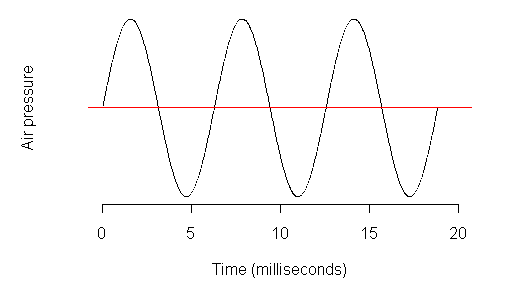

This simplest kind of wave is often called a sine wave [ˈsajn ˌwev]. (This is pretty much the graph you'd get if you plotted the results of pressing the "sin" key on your calculator.)
Three useful things to measure about a sine wave are:
The amplitude of a wave is the size of the pressure difference it causes.

Amplitude is usually measured in decibels (abbreviated dB). People will hear hear amplitude as loudness.
The wavelength of a wave is the physical distance between two comparable points in neighbouring cycles (e.g., the distance between to pressure peaks or between two pressure troughs). For phoneticians, this is the least interesting property.
The frequency of a sine wave is how often the wave repeats itself. It is usually measured in Hertz (abbreviated Hz), sometimes also called "cycles per second". People will hear the frequency of a sine wave as pitch, i.e., a high-frequency (often repeating) wave will sound like a high note, while a lower-frequency (not as often repeating) wave will sound like a lower note.
Frequency and amplitude are independent of each other. It is possible to have a low frequency wave with high amplitude (as in A below, which will be heard as a loud low-pitched note), a high frequency wave with a high amplitude (B, a loud high-pitched note), a low frequency wave with low amplitude (C, a quiet low-pitched note), or a high frequency wave with low amplitude (D, a quite high-pitched note).
| same frequency | same frequency | |
same amplitude |
A:  |
B:  |
same amplitude |
C:  |
D:  |
In the above diagram, the two waves in each column have the same frequency and the two waves in each row have the same amplitude.